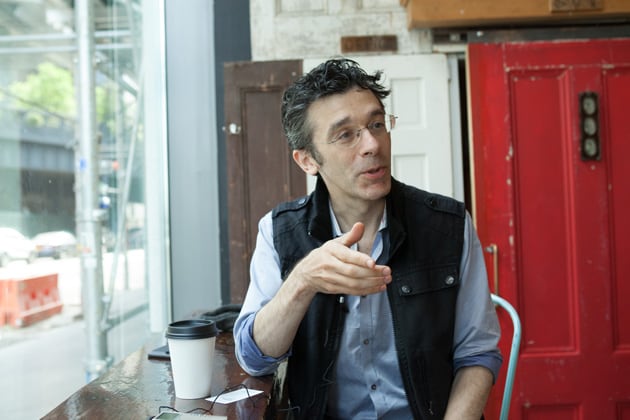
- Semiconductor Technology Now
Expert Interview
Telescope Magazine: What are you interested in right now?
Kevin Slavin: I'm interested in the idea that you could actually find out what is in the environment by sequencing the DNA,*2 not of people but of microbes that surround us. The problem is that many people have no idea that such a biological lens exists, and people who do know everything about it just does it for work, without realizing how powerful a tool it can be.
Telescope Magazine: What do you mean?
Kevin Slavin: About three or four years ago, there was an increasing amount of awareness and interest in the gut biome and the idea that you're not one organism, that you're basically a half a million organisms-a complex ecosystem consisting of microbes that interact sometimes symbiotically and sometimes in conflict.
Kevin Slavin: By mass, a lot of you is human, but genetically speaking, much more of your DNA belongs to other organisms that are in your gut, and those organisms have at least as much to do with your experience and outcomes as a human as the genetic material that you got from your parents.
Then I started thinking about cities such as Tokyo or New York as symbiotic beings full of microbes. When I was at the MIT Media Lab fulltime, we began a collaboration with Mori Building Company in which we sought to see cities not as the built environment for humans, but rather as holistic, biological organisms. In other words, we attempted to determine the biological organism of a city like Tokyo or New York.
Telescope Magazine: So you've shifted your attention from the biome of our bodies to that of cities?
Kevin Slavin: The biome of our bodies is now being studied by many researchers, but we've come to gain a broader awareness of the issue, which led us to a larger question: if I have a gut biome and it's different from your gut biome, does New York have a gut biome? Is it different from Tokyo's? When we began, I didn't even know if that was a valid question and I certainly didn't know if anybody else was working on it. So I brought in a number of collaborators and some students at the Media Lab, and we met with George Church who is among the core faculty of the Wyss Institute at Harvard. He said that if I wanted to know all about the microbes in New York, I'd have to capture and sequence their DNA. That led me to think about getting the DNA, and things started to become really interesting.
Telescope Magazine: Is it really possible to collect the DNA of all microbes that are there?
Kevin Slavin: I actually found three groups of scientists that were also investigating this research theme. One of them was also at MIT, and they were using robots in the sewer to sequence human waste. This method can be a very specific lens on the city.
The second group was at the University of Oregon. They were taking out the filters of the HVAC systems and sequencing what's in the filters, so as to track how microbes are moving through the building.
The third group was at Cornell University, and they threw in millions of dollars and hundreds of people to physically swab all of the surfaces of every subway station in New York City. But even after investing so much money and manpower, what you get is just one lens covering only the subway.
Telescope Magazine: It's a far cry from getting the DNA of the entire city.
Kevin Slavin: I was interested in the streets themselves, and thought about it a lot with my collaborators. Then I remembered an amazing story that happened a couple of years ago in Brooklyn. There were urban bee keepers there, and their honey turned bright red. They had to figure out how and why. Maybe it's poison. Who knows? Finally, they discovered that the bees had gotten into a maraschino cherry factory nearby where they make red syrup.
And that gave us an idea: if you want to find out what's happening in the city, ask the bees! It's also at a time when urban bee keeping has become a very popular topic. We designed basically bee hives that have a sterile tray at the bottom. The bees go out a mile and a half around the hive, pick up everything they come into contact with, and come back to the hive to shake it off. We pull out the sterile tray and send it to the lab for sequencing, and now we have a means of detecting what is in the city! We did that in Tokyo, Sydney, Melbourne, Brooklyn, and Venice, and have plans to do it in many other places.
 |
Telescope Magazine: So, now you can actually grasp what sort of microbes are in different cities.
Kevin Slavin: We discovered, of course, that cities have unique biomes, but my primary interest is in understanding what reality is. Cities are much more than anything we can see, and all those invisible parts are way more important than what's visible. I'm trying to build a sensibility around that.
The three groups of scientists I mentioned earlier are trying to figure out and solve some real problems. The data we collect is also very useful to them, and has become part of a broader scientific inquiry.
[Footnotes]
- *2
- DNA sequencing: The process of determining the order of nucleotides within a DNA molecule that represents genetic information.



















